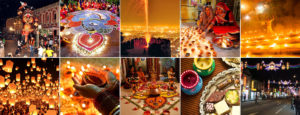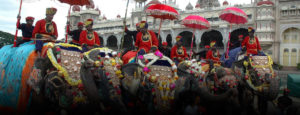India is not known far and wide as an exotic place for nothing. Though you find all the trappings of modern life – fast internet, metro railways, excellent mobile connectivity, expressways, luxurious hotels, and more – age-old rituals bordering on the horrifying and unbelievable, are still practiced in certain areas. Let’s take a look at 24 of the most unusual ones:
Table of Contents
Nag Panchami:
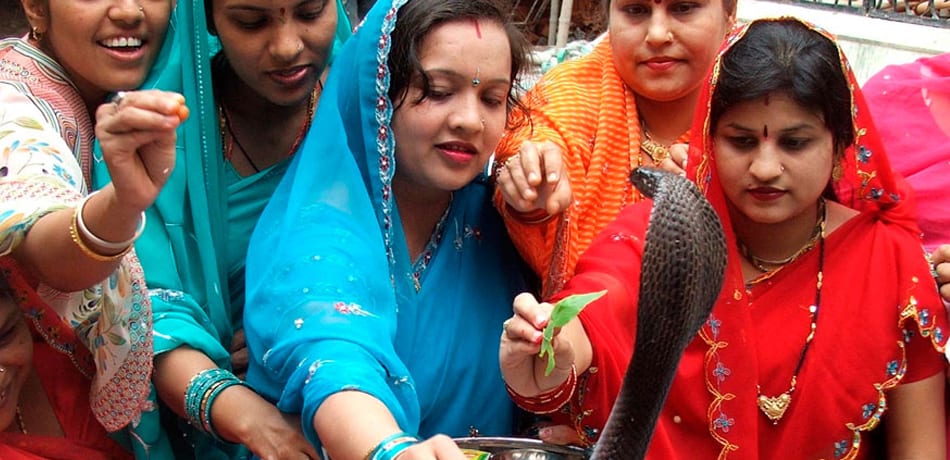
Festival of the Snake: It’s probably the most stereotypical image many Westerners have of India: A cobra with its hood spread and people around it!
The fifth day of the Hindu month of Shravan is celebrated as the festival of the snake; defanged live cobras are worshipped. Turmeric and vermillion and flower petals are sprinkled on them, and they are fed milk by devotees.
Pushkar Fair:
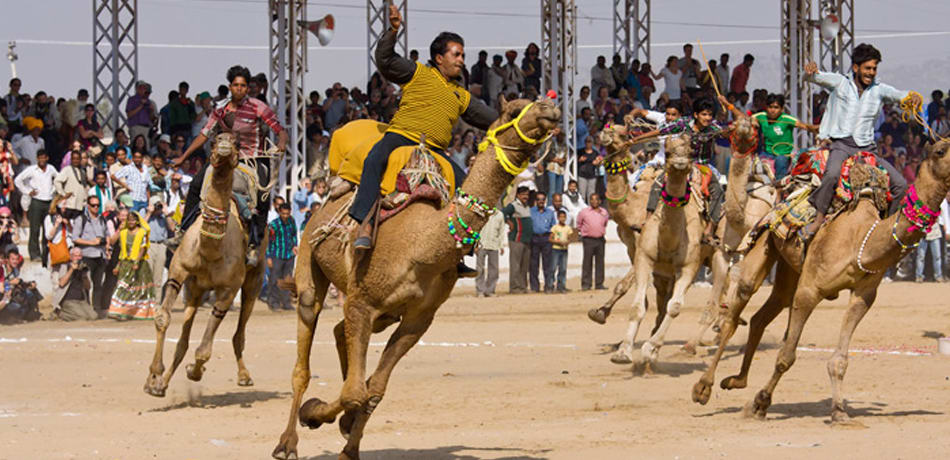
This is a cattle fair held in Pushkar Rajasthan during the Kartik Poornima full moon in November, and the focus is of course, on the Camel; to a lesser extent, you will find sheep, cows, and goats.
It lasts for 5 days, during which you will see camels shaved and decorated; they are paraded and entered in races, games, and beauty contests. Farmers and traders haggle and bargain and trade livestock.
A host of musicians, dancers, acrobats, and magicians entertain visitors, who can also pick up curios, fabrics, footwear, and other knick-knacks at the various stalls that are put up.
Check out the complete details of Pushkar Mela here.
Bani Festival:
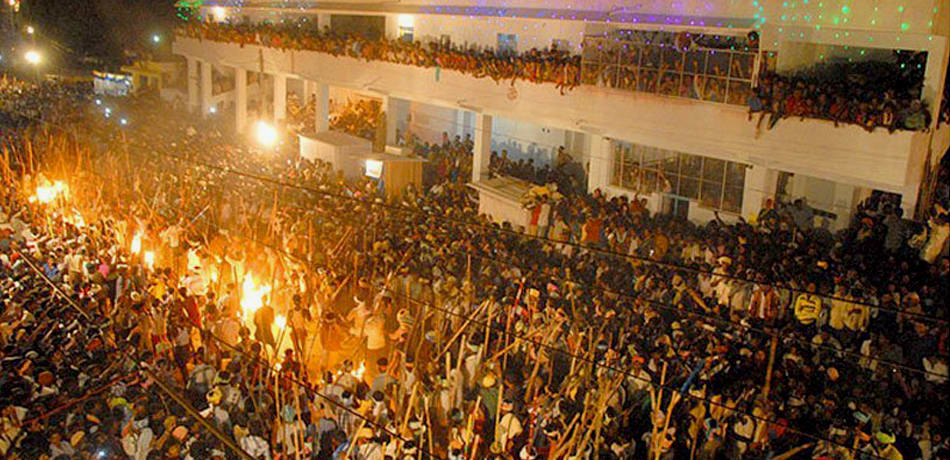
Celebrated in Andhra Pradesh at the Devaragattu Temple in Kurnool, this horrifying ritual involves devotees wielding sticks called lathis at one another to commemorate Shiva killing a demon.
Starting late at night, it continues till daybreak, with many people drenched in blood. The temple priests say that this tradition is over a hundred years old. Police and medical attendants are deployed to see that nobody is hurt too badly.
Tossing Infants from the Roof:
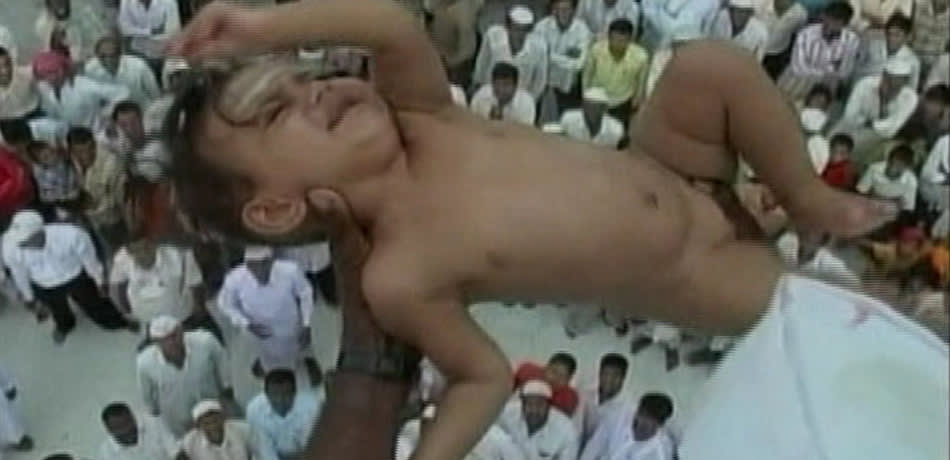
If Bani didn’t make your blood freeze, this surely will. Both Muslims and Hindus practice this bizarre and shocking ritual – supposedly to improve the family’s fortunes.
The infants are tossed from a height of 50 feet into a thick sheet held by men waiting below. Baba Umer Dargah near Sholapur, Maharashtra, and Sri Santeswar temple near Indi in Karnataka are the sites where this happens. This ritual has been happening for over 700 years, and so far, it seems that no injuries have been reported.
Puli Kali:
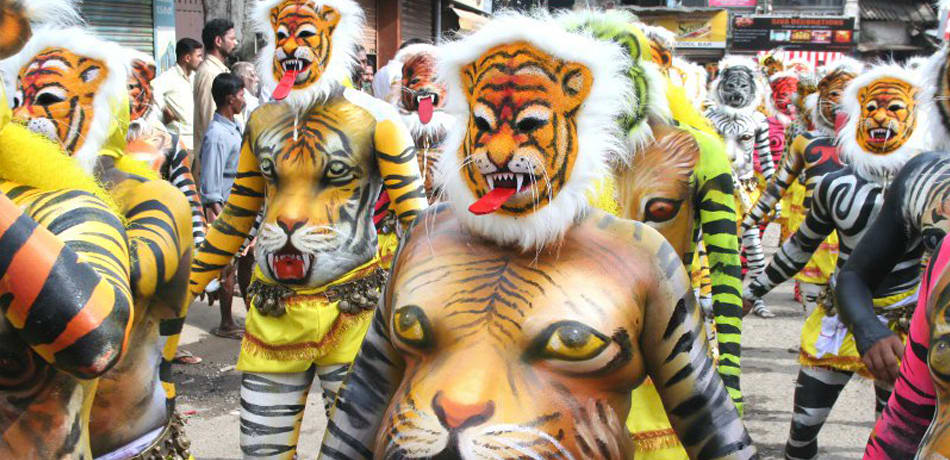
Nothing dangerous about this colorful Tiger Dance. Performed in Kerala by trained artists on the fourth day of the Harvest festival Onam (August-September), this dance attracts thousands of visitors from all over the state and country as well as abroad.
The performers wear masks and sport colorful body paint – to resemble tigers and leopards and dance to traditional rhythmic drumming.
Theemithi:
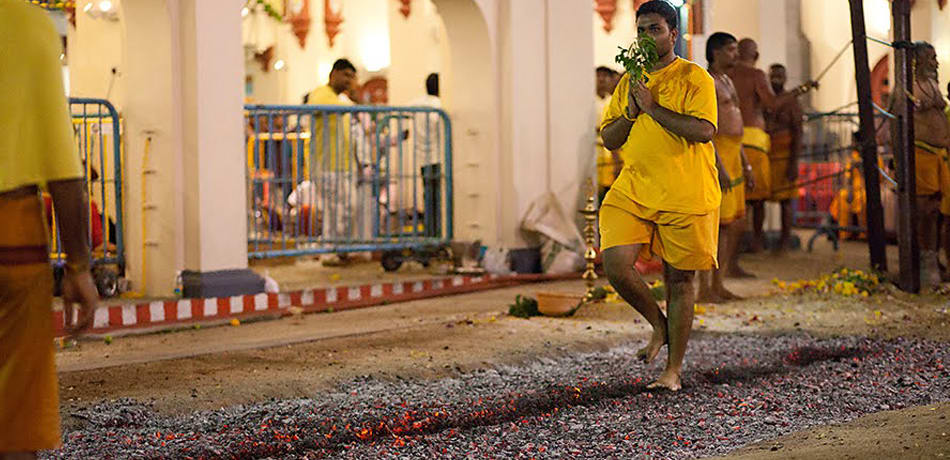
This ritual practiced in Tamil Nadu, involves walking on fire – yes, you read it right. Part of a large ceremony that goes on for over two months, theemithi commemorates Draupadi’s walking on a bed of fire after the great battle of Kurukshetra;
It is said she emerged from the fire unscathed and refreshed. The devout believe that on doing this, their wishes will be granted by the Goddess.
You can get a chance to enjoy the live performance of Theemithi with tamilnadu temple tour offered by HTOIndia.
Jallikattu:
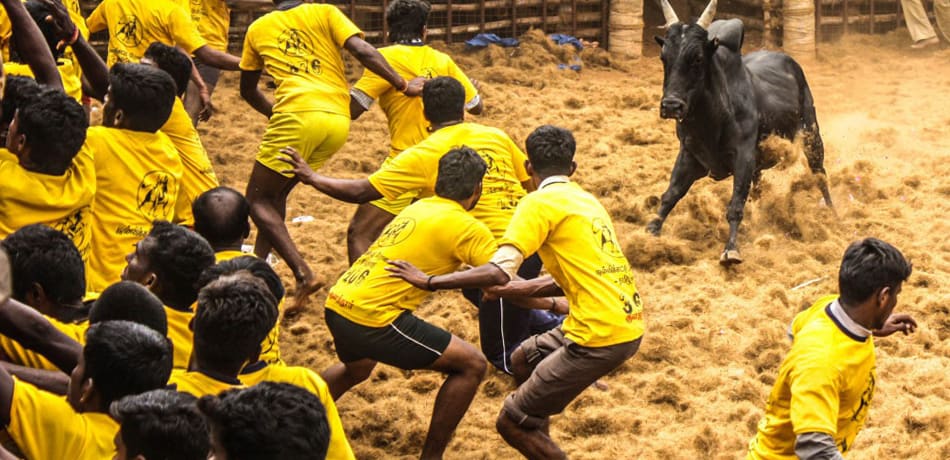
In the eye of a storm now, this is a traditional farmer’s sport where bulls (reared specially for the purpose) have their horns sharpened, where a prize is often attached.
Young men attempt to grab the prize and/or tame the bull by riding it. The bull is not killed after the taming; in fact, more men than bulls are injured in the process, as they are not allowed weapons. The sport was legally banned in 2014 but is still carried out in rural areas of Tamil Nadu.
Madey Snana:
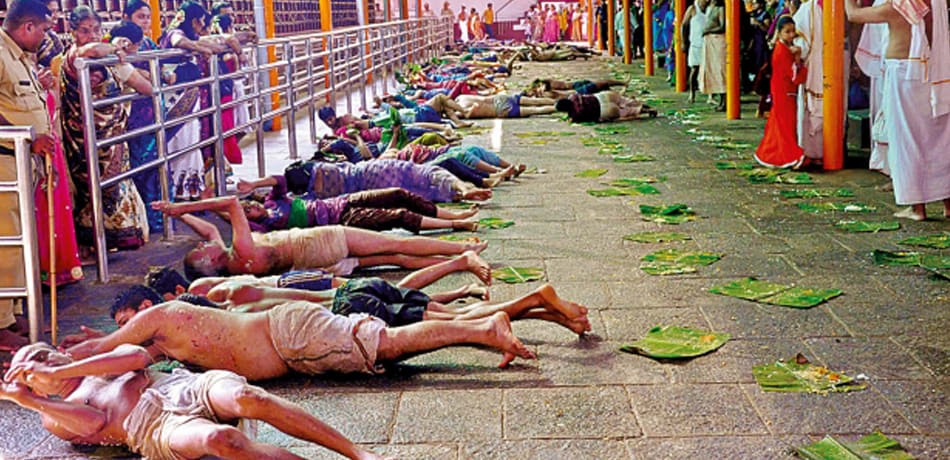
This ritual of ‘spit bath’ practiced in Karnataka will leave you astounded; At the Kukke Subramania Temple, people from so-called ‘lower castes’ roll on the floor over the leftovers of Brahmins – so-called ‘higher castes’ on Banana leaves, supposedly to cure themselves from ailments.
Though banned in 2010, it had to be revoked the next year due to heavy protests from the Malekudiya tribe.
Thaipoosam:
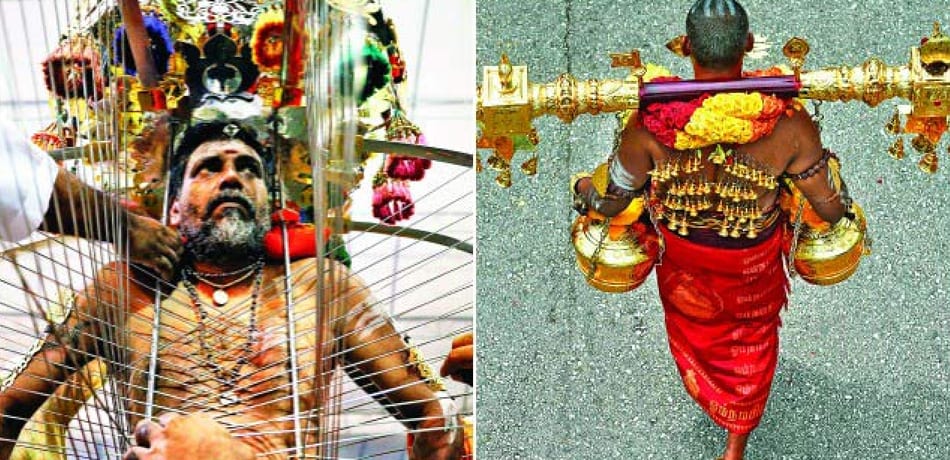
Faith makes people do strange things indeed. In a festival that honors Kartikeya (son of Shiva and Parvati) in the month of Thai, devotees pierce their tongues and cheeks, and other parts of the body with hooks, lances, and skewers.
Some even try to pull heavy objects while thus pierced. Incessant chanting and drumming accompany the devotees who supposedly enter a trance – it’s an eerily fascinating sight.
Aghoris:
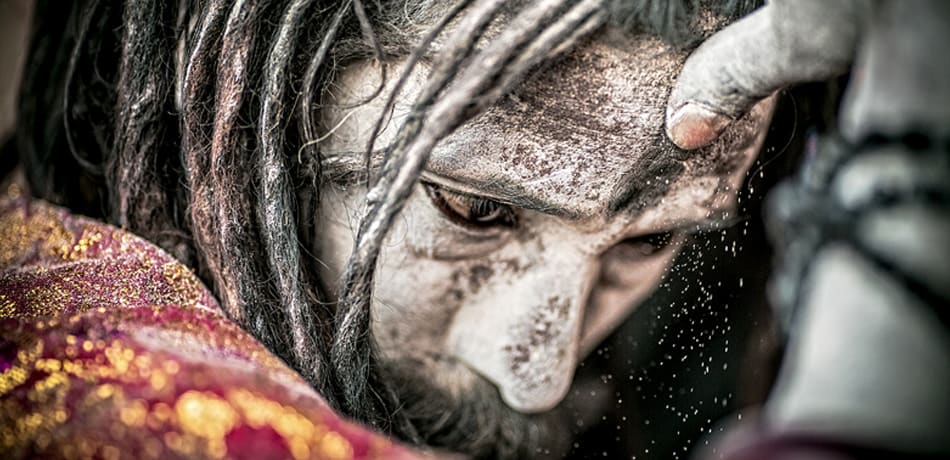
Found in the holy city of Varanasi and in parts of Uttarakhand, the Aghori sadhus are a frightening sight, with their long matted hair and (often)naked bodies covered in ash.
They indulge in shocking rituals like eating human remains just before or after they are cremated, and having sexual intercourse with corpses. Many people flock to get their blessings as it is believed that they have healing powers.
Visit Rajim Kumbh Mela to learn more about Aghoris.
Govardhan Puja:
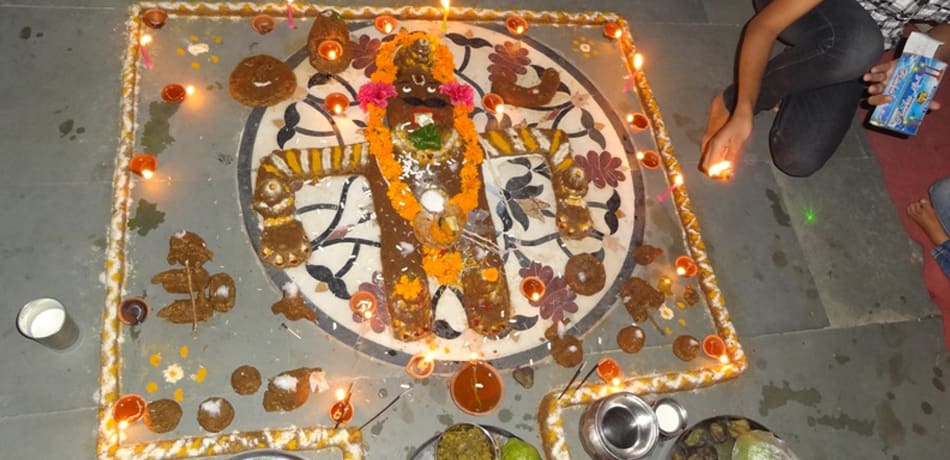
The day after Diwali, Enadakshi is set aside for this bizarre ritual in Bhiwdawad village in Maharashtra. Cattle are bathed and decorated with flowers, colored powder, and henna, and are made to walk on people lying on the ground.
People believe that by allowing the cows to trample them, they can appease the Gods into granting their prayers; mind you, they fast for 5 days before the ritual!
Visit Diwali Festival In India to learn more about Govardhan Puja.
Animal Weddings:
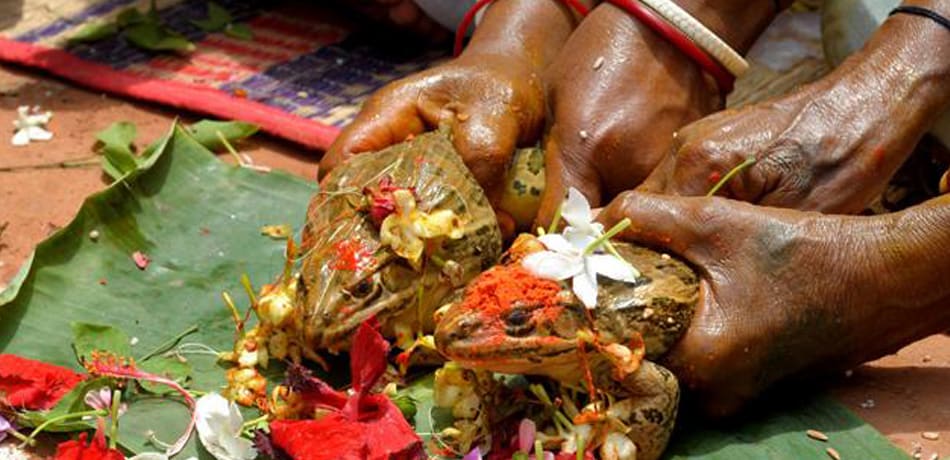
Rains matter a lot in India – even today, much of the agriculture depends on seasonal rain. Little wonder that people will try anything to appease the rain gods!
The amusing animal weddings are performed with the hope of a good monsoon: frogs in Maharashtra and Assam, donkeys in Karnataka, and dogs in some other states! All the traditional rituals are performed, and the nuptials are conducted by a real priest, with a fest being served afterward.
Garudan Thookam:
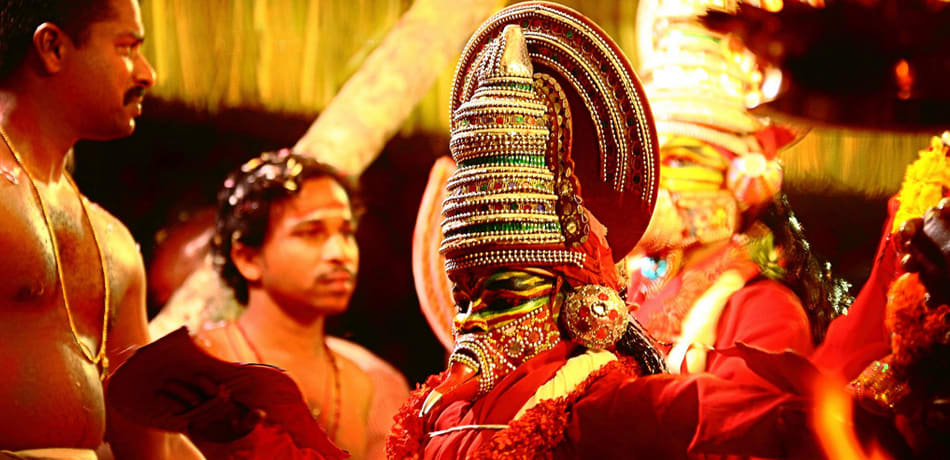
This eerily fascinating art form is performed in Kerala by performers dressed up as Garuda, the vehicle of Lord Vishnu. It is believed that Faruda quenched Goddess Kali’s thirst for blood by slaying the demon Darika.
After the dance performance, the flesh on their backs is pierced with hooks and they hang from a shaft to resemble Garuda – an eagle. They are taken out in a colorful procession; this ritual takes place on Bharani day in Kumbham and Makaram months.
Kesh Lochan:
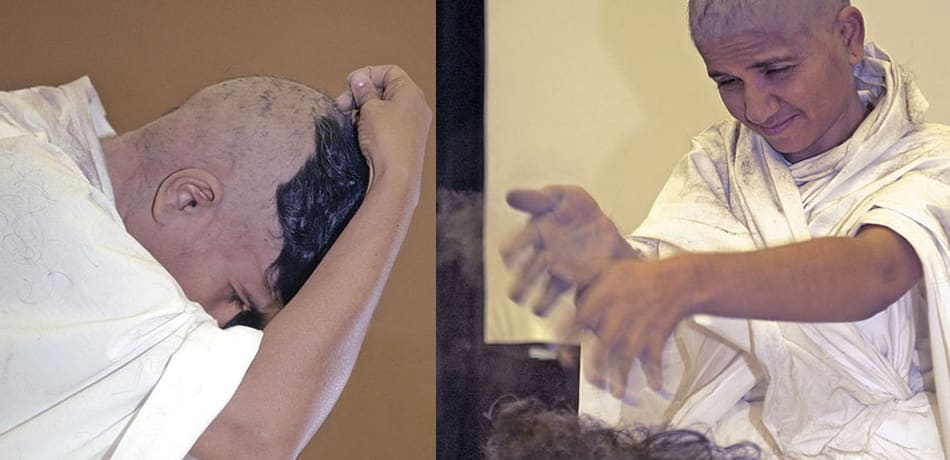
Shaving off the hair on the head is commonly followed in many religions; but with your own hands? The Jains renounce worldly attachments by pulling out each individual strand with their own hands – as hair is considered to be a symbol of attachment and vanity. Their wounds are covered in ash or cow dung for healing.
Dhinga Gavar:
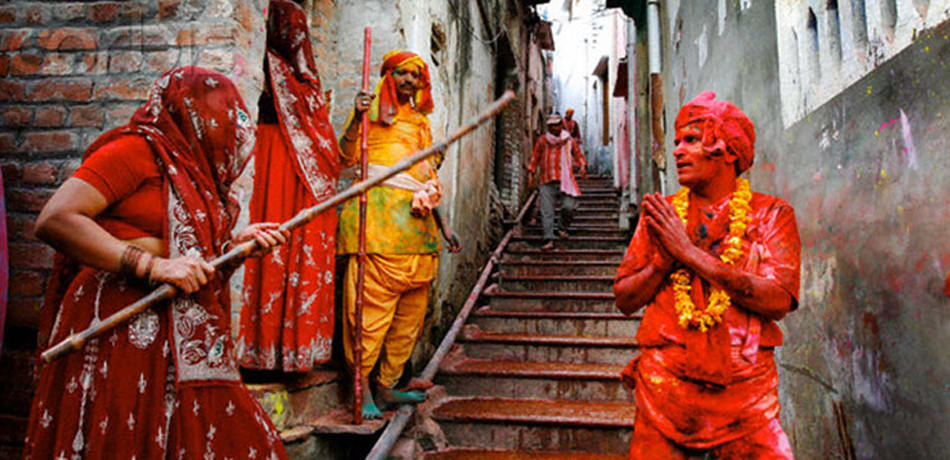
Celebrated in Jodhpur, Rajasthan, this is a strange but fun festival – ; literally translates into fun by deceotion’ – is part of the Gangaur (Goddess Parvati) festival. It is said that Parvati had once dressed up as a tribal woman and playfully teased her husband, Lord Shiva.
After sunset, statues of Dhinga Gavar (the playful side of Gangaur) are decorated with loads of gold, and placed at 11 locations throughout Jodhpur. Women dress up in a range of costumes – gods, goddesses, saints, police, dacoits – and take out processions, wielding lathis to use against those who try to snatch the statues!
The deity is offered Cannabis on the day; it is believed that an unmarried man who gets hit by a woman’s stick because he was too close to the statue, will tie the knot soon!
Agni Keli:
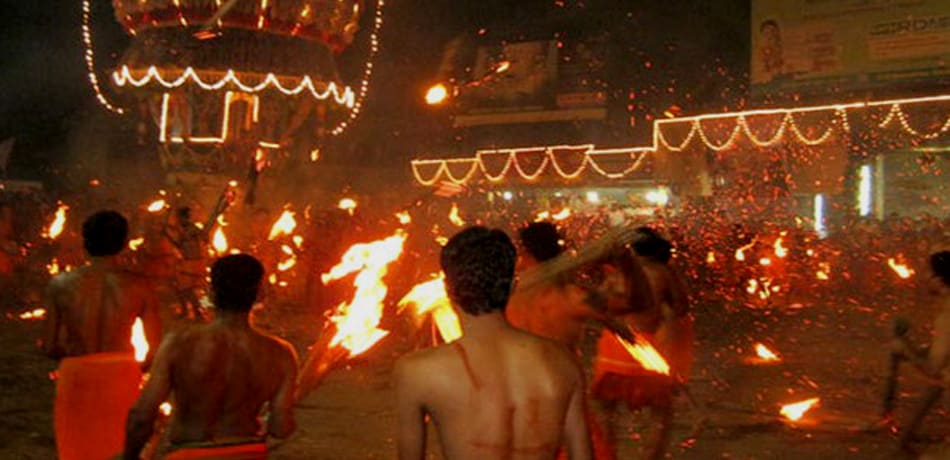
Come April, and you will see this horrific ritual take place in the Kateel Durga Parameswari Temple in Mangalore. Hundreds of devotees(with bare upper bodies) hurl burning fronds of the palm tree at one another!
This ancient tradition is part of an 8-day festival which also includes several themed performances. Sacred vermillion powder mixed with water is sprayed on the burns to heal them.
Aadi Festival Coconut Smashing on Head:
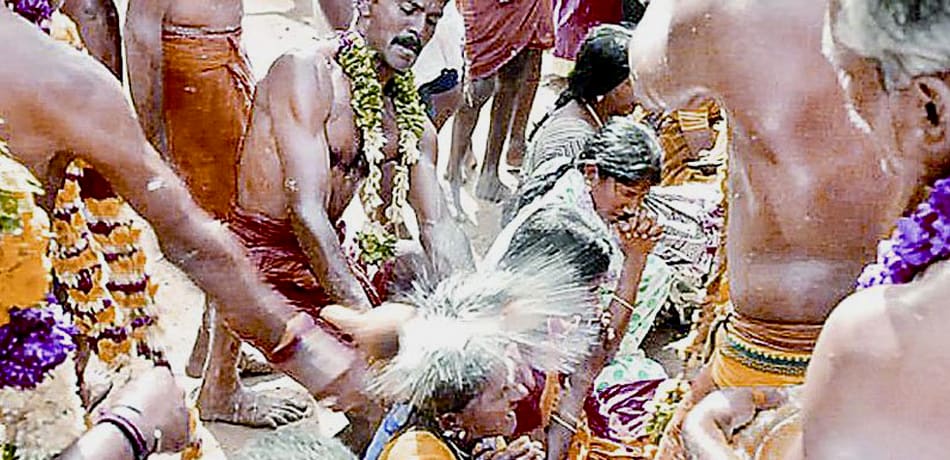
In the Tamil month of Aadi, thousands of the faithful visit the Mahalakshmi Temple, Mettu Mahadhanapuram, in Karur, Tamil Nadu, and have coconuts smashed on their heads! They believe it will bring them good fortune.
This mind-boggling ritual has its roots in the British Raj. The foreign rulers wanted to build a railway track across the temple, but villagers resisted. To test their faith, the British asked them to break coconuts on their heads.
If they succeeded, the track would be built elsewhere. They did succeed, and the temple was saved, and the ritual is still performed.
Varuna Yajna:
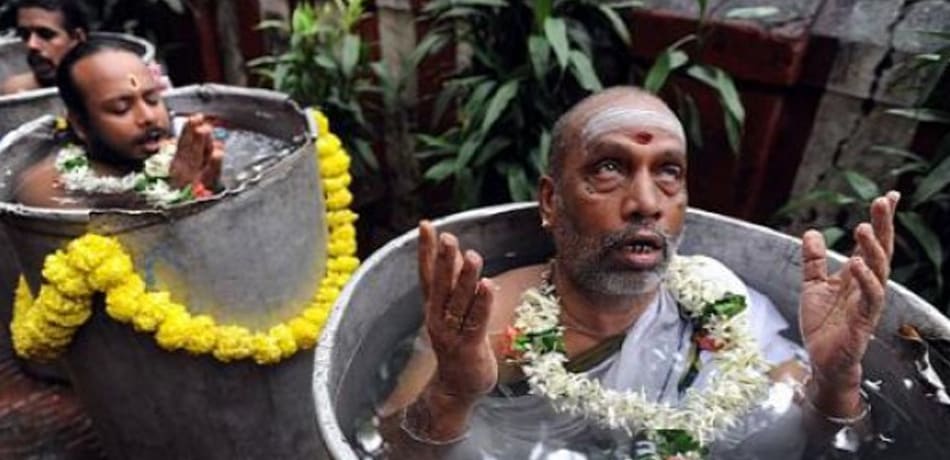
Comparatively less dangerous than some of the other rituals you’ve read about till now, this is a ritual performed to appease Varuna, God of Water.
The priests of temples in Maharashtra, Karnataka, and Tamil Nadu stand submerged in barrels of water, chanting Varuna’s name one lakh times.
Aoleang Monyu Festival:
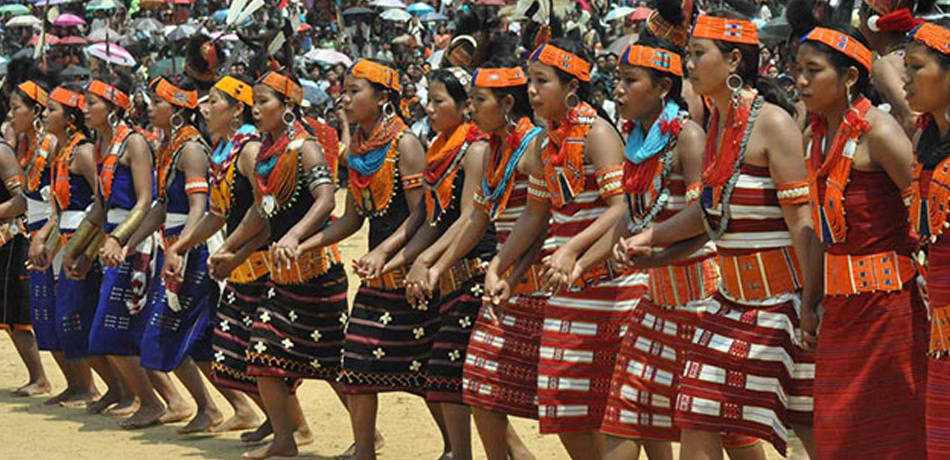
This festival is celebrated in Nagaland by the erstwhile dreaded ‘headhunters’, the Konyaks. This vibrant spring festival is held with the hopes that the spirit Wangwan will be pleased and give them a bountiful harvest.
The people symbolize the spirit by erecting a bamboo with branches, and tender palm leaves hanging in the front. They praise the spirit and invoke its spirit. It lasts 6 days, attracting people from the whole of North Eastern India.
You can see the people dressed in colorful and attractive traditional costumes; they perform dances to folk songs, and have a humongous feast, with a wide variety of ethnic cuisine. Rice beer is prepared in advance for the big day, and consumed in large quantities. Each of the 6 days has its own special significance.
One day is for weaving traditional fabric, making rice beer, and collecting wood and vegetables; a chicken is sacrificed, and the future is predicted, based on the shape of its intestines! Young boys are trained to hunt on days 2 and 3, with the remaining days witnessing boisterous festivities with lots of beer, indigenous sports, games, music, and dance.
Ayudh Puja:
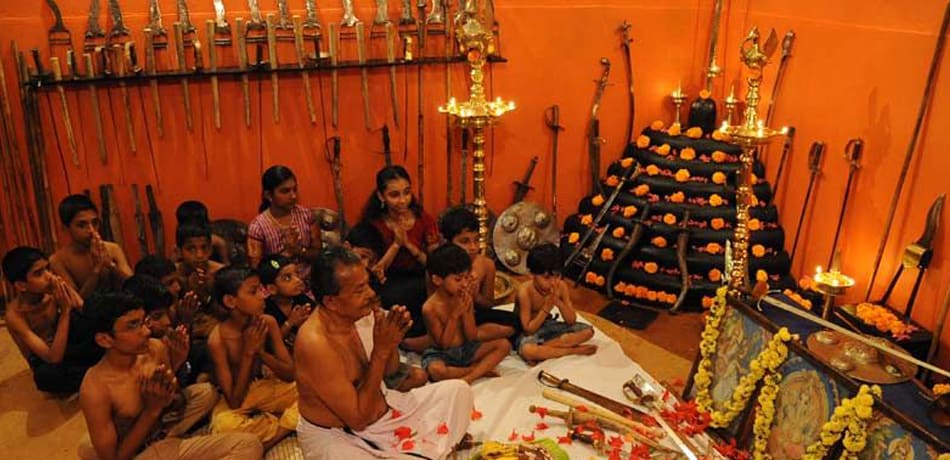
Worship of weapons, implements, tools, and gadgets – this is done as part of the Navratri festival; held all over India, the rituals vary slightly in each state.
Even the armed forces conduct this ceremony, with battalions performing the worship of their weapons wherever they are posted.
Marrying Animals for Exorcism:
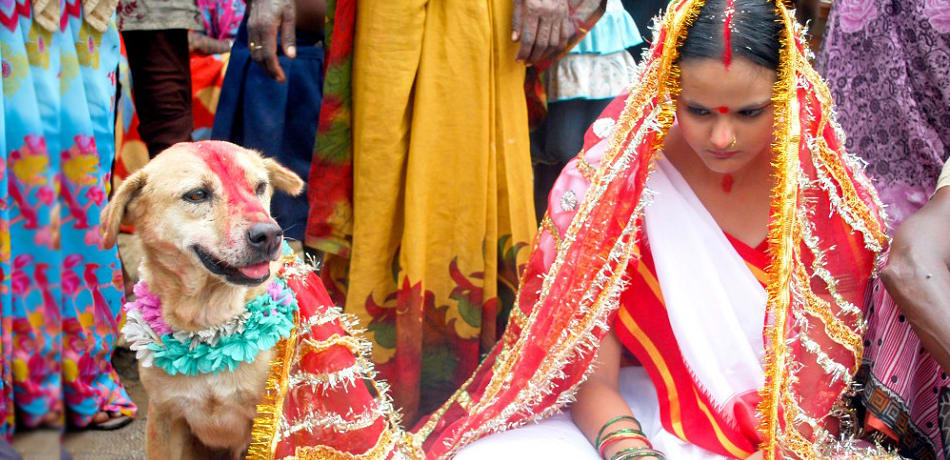
Yes, this inexplicable ritual still continues today – supposedly to exorcise the spirits in (mostly) young girls. A marriage ceremony is conducted if a girl is believed to be possessed (usually if she has any deformity); the groom is usually a dog or goat.
Ambubachi Mela:
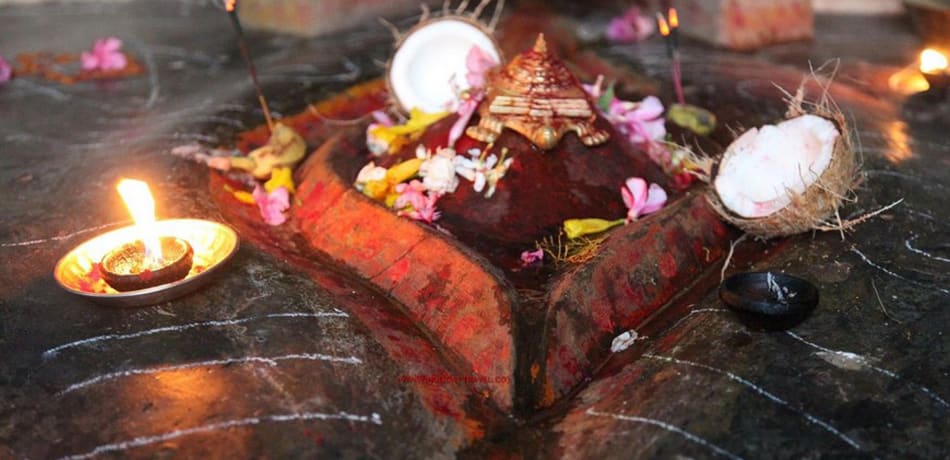
Menstruation is a taboo subject in India still; yet the Kamakhya temple in Guwahati, Assam, celebrates the menstrual cycle of the Goddess – once a year, for 3 days in June.
It is said that Sati, Shiva’s wife, jumped into the fire, pained by the insults heaped on her husband by her father. A grief-stricken and enraged Shiva picked up her corpse and did the terrible Taandav dance, causing parts of her body to fall to the Earth.
Each part formed a Shakti Peetha, where temples were built to commemorate her. This temple was built where her Yoni, or vagina, fell. On these 3 days, the temple is closed and is believed to turn red inside.
This festival draws Aghoris and ascetics from all over, displaying their tantric, mystic, and psychic powers. The color red is very prominent – flowers, clothes, vermillion – can be seen in plenty.
Kila Raipur Rural Olympics:
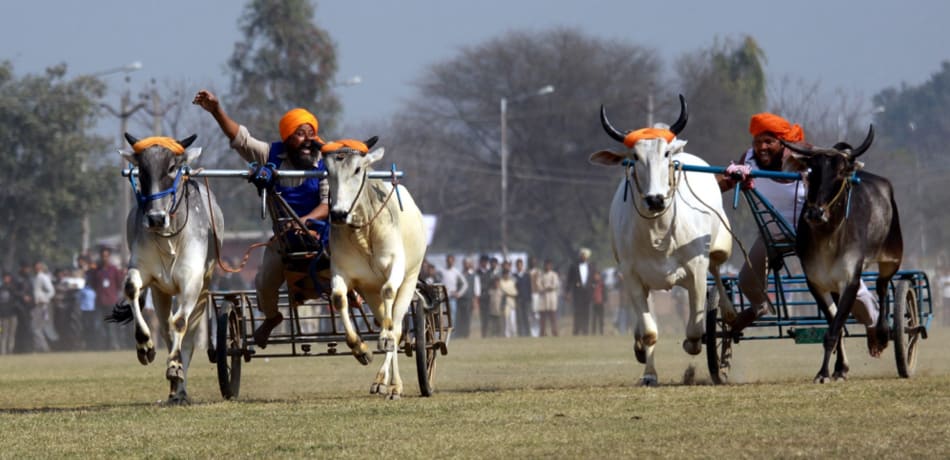
This doesn’t have a religious significance but is a festival held with great zeal, and enjoyed by thousands. Domestic and foreign visitors throng this unusual sports competition in Punjab’s Raipur district.
Competitions include races of bullock carts, horse carts, and mule carts, shot put, tug-of-war, traditional Indian sport Kabaddi, tractor race, high and long jumps, and middle distance racing.
Daredevil stunts are performed on bikes and horses, and strongmen attempt to pull tractors and sometimes trucks, with their hair, teeth, and – you may not believe this – their ears! Evenings are reserved for dance and music – hearty and boisterous, and thoroughly enjoyable.
Bhagoriya Festival:
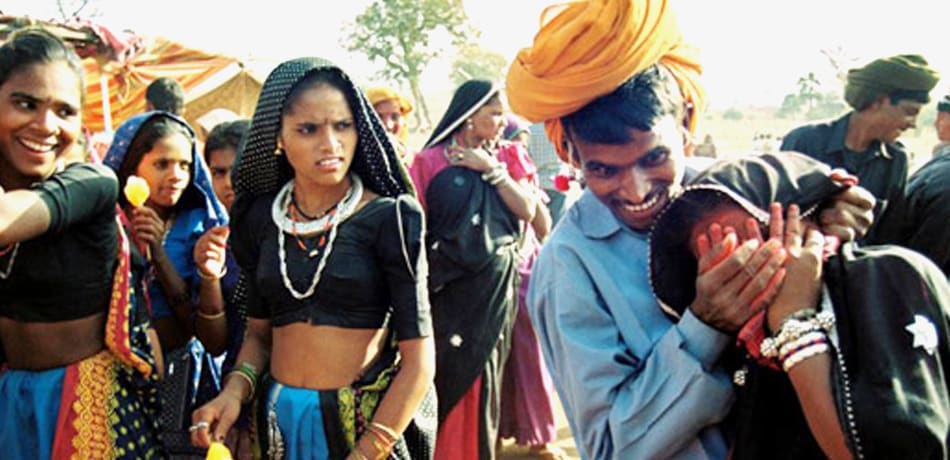
Held in Madhya Pradesh just before the Spring Festival Holi, this festival enables young boys and girls to elope with each other – isn’t that fascinating? The Bhil and Bhilala tribes hold this ritual as a sort of mass wedding ceremony.
A boy applies red powder on the face of the girl he fancies; if she returns the favor, they both elope together and are married. If she does not, he gets one more shot at trying to win her heart. If she does not relent still, he has to try his luck elsewhere.
I’m sure that after reading this, you are convinced that truth is indeed stranger than fiction. Believe it or not, these outlandish rituals are alive and thriving in India; perhaps it’s part of the magic that attracts people to her from all over the world! Come, experience these and many other mystical sights and sounds of this ancient land.
Call us at +91-9829488511 now or click here to get in touch with us. Just tell us your budget, when you’d like to travel, and what you’d like to see, and we will get back to you with an itinerary.


